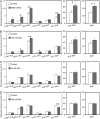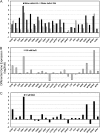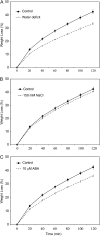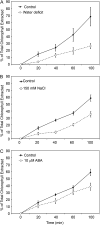The impact of water deficiency on leaf cuticle lipids of Arabidopsis
- PMID: 19819982
- PMCID: PMC2785987
- DOI: 10.1104/pp.109.141911
The impact of water deficiency on leaf cuticle lipids of Arabidopsis
Abstract
Arabidopsis (Arabidopsis thaliana) plants subjected to water deficit, sodium chloride (NaCl), or abscisic acid treatments were shown to exhibit a significant increase in the amount of leaf cuticular lipids. These stress treatments led to increases in cuticular wax amount per unit area of 32% to 80%, due primarily to 29% to 98% increases in wax alkanes. Of these treatments, only water deficit increased the total cutin monomer amount (by 65%), whereas both water deficit and NaCl altered the proportional amounts of cutin monomers. Abscisic acid had little effect on cutin composition. Water deficit, but not NaCl, increased leaf cuticle thickness (by 49%). Electron micrographs revealed that both water-deprived and NaCl-treated plants had elevated osmium accumulation in their cuticles. The abundance of cuticle-associated gene transcripts in leaves was altered by all treatments, including those performed in both pot-grown and in vitro conditions. Notably, the abundance of the ECERIFERUM1 gene transcript, predicted to function in alkane synthesis, was highly induced by all treatments, results consistent with the elevated alkane amounts observed in all treatments. Further, this induction of cuticle lipids was associated with reduced cuticle permeability and may be important for plant acclimation to subsequent water-limited conditions. Taken together, these results show that Arabidopsis provides an excellent model system to study the role of the cuticle in plant response to drought and related stresses, and its associated genetic and cellular regulation.
Figures








Similar articles
-
Leaf cuticular lipids on the Shandong and Yukon ecotypes of saltwater cress, Eutrema salsugineum, and their response to water deficiency and impact on cuticle permeability.Physiol Plant. 2014 Aug;151(4):446-58. doi: 10.1111/ppl.12127. Epub 2013 Dec 24. Physiol Plant. 2014. PMID: 24215503
-
Arabidopsis ECERIFERUM9 involvement in cuticle formation and maintenance of plant water status.Plant Physiol. 2012 Jul;159(3):930-44. doi: 10.1104/pp.112.198697. Epub 2012 May 25. Plant Physiol. 2012. PMID: 22635115 Free PMC article.
-
Arabidopsis DREB26/ERF12 and its close relatives regulate cuticular wax biosynthesis under drought stress condition.Plant J. 2024 Dec;120(5):2057-2075. doi: 10.1111/tpj.17100. Epub 2024 Oct 28. Plant J. 2024. PMID: 39466828 Free PMC article.
-
MdCER2 conferred to wax accumulation and increased drought tolerance in plants.Plant Physiol Biochem. 2020 Apr;149:277-285. doi: 10.1016/j.plaphy.2020.02.013. Epub 2020 Feb 14. Plant Physiol Biochem. 2020. PMID: 32088579 Review.
-
Interplays of Cuticle Biosynthesis and Stomatal Development: From Epidermal Adaptation to Crop Improvement.J Agric Food Chem. 2024 Nov 20;72(46):25449-25461. doi: 10.1021/acs.jafc.4c06750. Epub 2024 Nov 8. J Agric Food Chem. 2024. PMID: 39513411 Review.
Cited by
-
Differential regulation of triterpene biosynthesis induced by an early failure in cuticle formation in apple.Hortic Res. 2021 Apr 1;8(1):75. doi: 10.1038/s41438-021-00511-4. Hortic Res. 2021. PMID: 33790248 Free PMC article.
-
Study of nsLTPs in Lotus japonicus genome reveal a specific epidermal cell member (LjLTP10) regulated by drought stress in aerial organs with a putative role in cutin formation.Plant Mol Biol. 2013 Jul;82(4-5):485-501. doi: 10.1007/s11103-013-0080-x. Epub 2013 Jun 4. Plant Mol Biol. 2013. PMID: 23733601
-
Increased Cuticle Permeability Caused by a New Allele of ACETYL-COA CARBOXYLASE1 Enhances CO2 Uptake.Plant Physiol. 2020 Dec;184(4):1917-1926. doi: 10.1104/pp.20.00978. Epub 2020 Sep 29. Plant Physiol. 2020. PMID: 32994218 Free PMC article.
-
Acyl-lipid metabolism.Arabidopsis Book. 2010;8:e0133. doi: 10.1199/tab.0133. Epub 2010 Jun 11. Arabidopsis Book. 2010. PMID: 22303259 Free PMC article.
-
The Glycerol-3-Phosphate Acyltransferase GPAT6 from Tomato Plays a Central Role in Fruit Cutin Biosynthesis.Plant Physiol. 2016 Jun;171(2):894-913. doi: 10.1104/pp.16.00409. Epub 2016 Apr 19. Plant Physiol. 2016. PMID: 27208295 Free PMC article.
References
-
- Barrs HD, Weatherley PE (1962) A re-examination of the relative turgidity technique for estimating water deficits in leaves. Aust J Biol Sci 15 413–428
-
- Bartels D, Sunkar R (2005) Drought and salt tolerance in plants. Crit Rev Plant Sci 24 23–58
-
- Bonaventure G, Beisson F, Ohlrogge J, Pollard M (2004) Analysis of the aliphatic monomer composition of polyesters associated with Arabidopsis epidermis: occurrence of octadeca-cis-6,cis-9-diene-1,18-dioate as the major component. Plant J 40 920–930 - PubMed
Publication types
MeSH terms
Substances
LinkOut - more resources
Full Text Sources
Other Literature Sources
Molecular Biology Databases

